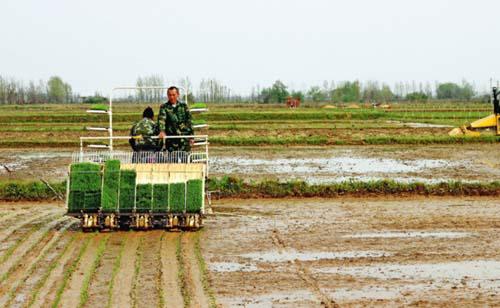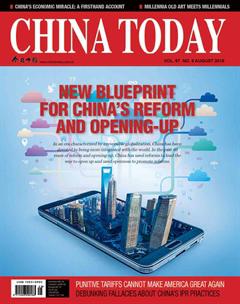Rural Revival:Jiangxi’s Story
By special correspondents LIU YONG, SONG HAIFENG & HUAN YU


HU Aixi, a farmer in Poyang County, southeast Chinas Jiangxi Province, is all smiles after his rice crop made a handsome profit this year. Thanks to the cooperation with the giant food enterprise China Resources Ng Fung Limited (CR Ng Fung) reached two years ago, Hu sold the rice he planted in his 120 mu (about 8 hectares) rice paddy at a price 5 percent higher than the market rate.
“I can make over RMB 60,000 this year, nearly RMB 20,000 more than previous years,” Hu told China Today.
Hu is one of the many farmers on Zhuhu Farm in Poyang County dedicated to ecological farming and rewarded with high returns. Such operations form part of Chinas national rural revitalization campaign. Jiangxi, which has a long and rich history of agriculture, has been exporting grains to other provinces since the establishment of the Peoples Republic of China. The local provincial government is fine-tuning this campaign by incorporating thriving businesses, a pleasant living environment, improved social etiquette and civility, effective governance, and better standard of living into the modern rural lifestyle.
Fostering Agribusiness
Thriving businesses are pivotal in advancing the rural revitalization strategy. The province has placed supplying quality agricultural produce on the top of its agenda to carry out supplyside structural reform in rural areas. It initiated nine agricultural development projects including planting quality rice, vegetables, fruits and tea, as well as developing rural tourism, in an attempt to build local agricultural brands. Quality rice planting spearheads the efforts.
The machines with thundering sounds in a rice mill of Zhuhu Farm signal the automatic rice production line is in operation. According to a superintendent there, a rice production line with a capacity of 150 tons was introduced when the farm established a partnership with CR Ng Fung in 2016. “The added value of rice is significantly improved as we are able to process rice, rice noodles, and other byproducts,” he noted.
To ensure eco-friendly farming, Zhuhu Farm takes measures to improve and fertilize the soil with natural ways, aiming at growing quality and nutri-tious rice while not harming the environemnt. Teaming up with the Chinese Academy of Agricultural Sciences and China National Rice Research Institute, the farm introduces and promotes new varieties of rice and new growing technologies, setting up a batch of largescale, specialized rice growing bases.
Meanwhile, the farm encourages a plant-to-order approach and pays heed to value chain. With the market, businesses, and rice growing bases coordinated with each other, the order price per kg rice is 10 to 15 percent higher than the market rate.
As a region with relatively weak secondary and tertiary industries, Zhuhu Farm manages to accelerate the development of modern agriculture. With farming now seen as a profession, locals like Hu are enjoying the fruits of their labor in the agricultural sector bringing in added value of RMB 70 million, with RMB 41 million being net profit in 2017. The income for local farmers averaged around RMB 60,000.
But for Zhuhu Farm this is only the tip of the iceberg. In 2018, the farm started an ambitious plan of building an agribusiness complex comprising of a rice processing industrial park, a freight terminal, a logistics center, and rural tourist sites, to boost an integrated development of the first, secondary, and tertiary industries.
The whole of Jiangxi Province is inspired by the success of Zhuhu Farm. The provincial government plans to replicate the agribusiness complex in 100 counties in an effort to improve agricultural performance and farmerslivelihoods. By 2020, a total of 28.25 million mu (about 1.88 million hectares) of farmland will have been improved and better developed in the province.
Beautiful Countryside
The previously impoverished county of Wanan in south central Jiangxi Province is unrecognizable today. A decade ago, Wanan County, the second largest county with a relocated population and a vital part of the Jinggang Mountain Old Revolutionary Base was a collection of dilapidated villages scattered across the mountainous region.
Today modern houses are arranged in an orderly fashion and crumbling walls have been repaired and used to showcase colorful paintings by local farmers. A senior resident surnamed Luo knows everything about the changes. “It feels like we are now living in a painting. The living environment is improving year by year. The road gets wider, the water gets clearer, and people become more vibrant,” said the 70-year-old.
The changes are attributed to efforts of reducing poverty through industrial development. According to Li Weiping, Secretary of Wanan County Committee of the Communist Party of China, the county rolled out a plan to support one business in every town, and one industrial base, one agricultural cooperative, one photovoltaic power station and one e-commerce service station in each vil- lage to promote local agribusiness and raise farmers incomes. “For poor households that are short of initial funds, the government offers a minimum subsidy of RMB 5,000 so that they can start a business,” said Li, emphasizing the governments urgency to help farmers.
Lüfeng Fruit Cooperative, initiated by Deng Lanyun, is a case in point of getting people out of poverty through industrial development. Deng, together with her fellow farmers, has planted 20 varieties of fruits including tangerines, honey pomelos, peaches, and plums. Having expanded from 320 mu (about 21 hectares) to a current scale of 5,000 mu (about 333 hectares), the cooperative now has its own registered Fujing brand and a sales network, benefiting some 100 households.
Local historical and cultural legacies are also assets to develop distinctive businesses. Farmers in Wanan County have enjoyed a reputation for artistic creativity throughout their history. The works they paint are of artistic value and reflect the local rural life. Wanan is, therefore, dubbed the county of farmerspaintings. In April 2017, the county in-troduced a series of policies to support local farmers to create their artworks and turn them into businesses. It invited well-known painters and university teachers to the county for exchange and training programs, aiming at helping local painters improve their techniques. The county also built an industrial base for developing the farmers art industry by integrating exhibitions, trainings, sales, and rural tourism.
With farmers art as the core business, Wanan has developed scenic spots such as tea gardens and tourist activities such as rafting trips. By connecting these services, two rural sightseeing belts have taken shape. The thriving agribusiness and farmers art-based tourism make Wanan County exemplary in building a beautiful countryside and shaking off poverty in Jiangxi Province.
In the next three years, the province plans to build a beautiful countryside by renovating 20,000 villages, and efforts will be made to balance the development of rural tourism and the improvement of peoples lives.
Sharing the Benefits
“Our village finally has a secured source of income,” said Lai Yiming, a village Party chief in Pingxiang City, west Jiangxi Province. “This year, we will have a rent income of RMB 45,000 from a piece of land which has been rent out to an enterprise to run a pottery business and tourism revenue of RMB 44,000 from hospitality and ticket sales.” In 2017, the village adopted a new practice of doing business. Residents were encouraged to pool their capital, labor or resources, to establish a startup where contributors are all shareholders. The move has resulted in collective benefits. In the past, the village collective economy was like an empty shell, resulting in the village Party branch unable to carry out concrete projects to benefit local people. Enterprises established by some residents were booming, but the majority of local people stayed poor. Most villages in the city faced such a plight.
Things began to change when local government suggested the concept of crowdfunding. Sanwan Village was chosen as a pilot. With village officials and Party members taking the lead, 386 residents in 83 households contributed the funds and set up a council for building a beautiful countryside. With a WeChat (a Chinese social media platform) group set up for crowdfunding, the village raised RMB 32,000 from 19 households in 2017, with which small factories for making chopsticks, toothpicks, and brooms were established. In just six months they saw sales revenue reach RMB 120,000. A dividend of RMB 100 was given to each household. In 2018, the village raised another RMB 1.2 million through crowdfunding. It shut down a polluting pig farm covering an area of 10 mu (about 0.67 hectare) and cooperated with an enterprise to establish a pottery business on this piece of land. The village also developed an ecological tourism resort with activities such as rafting trips available. It is estimated that every household will have an extra income of RMB 10,000 every year thanks to these projects. The village collective economy coffers now hold in excess of RMB 500,000 in revenue.
The success of Sanwan Village strengthened the determination of local government to develop the village collective economy. Village Party branches across the region began to follow suit by making use of idle resources. By taking advantage of natural assets like the farmland, forests, and grasslands, along with tradable assets such as real estate, construction land, and infrastructure, the value of the assets was invested as shares in ventures, cooperatives, and family farms. Idle resources are put into efficient use in this way. Farmers income channels are also expanded.
Obviously, furthering reform and enriching the rural economy is the path to agricultural development in Jiangxi Province. In 2018, the province is working on delegating the management rights of land to farmers and protecting farmers contractual rights to land so that farmers could be real owners, managers, and beneficiaries of rural collective assets. Meanwhile, the province encourages village collective organizations to participate in developing the rural economy by pooling resources or investments to launch and develop businesses in almost every village in Jiangxi by 2020.

